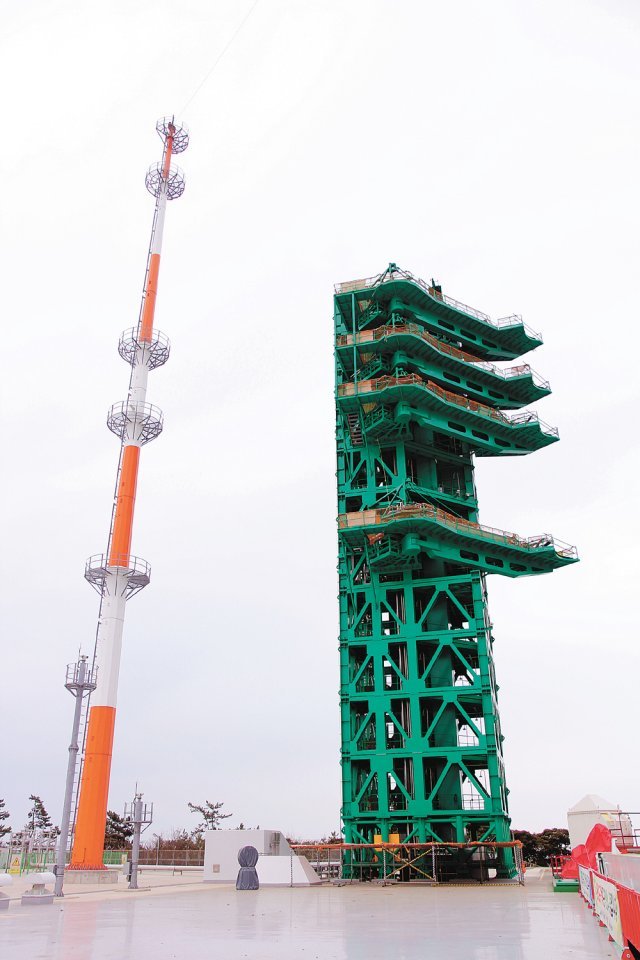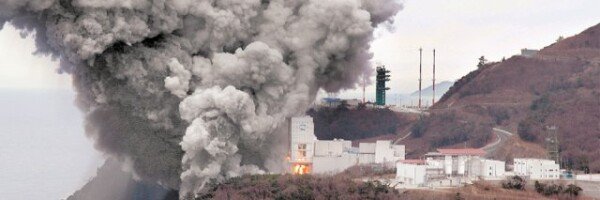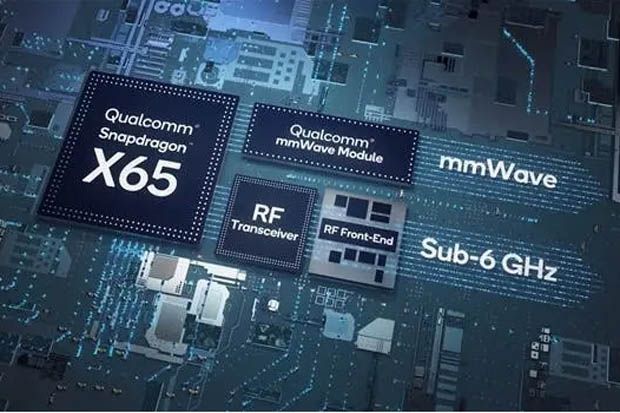2nd performance test result of propulsion engine
Four 75t engines burned 1 ton per second, with kerosene as fuel and oxidant to burn fuel. With a power of 1200t, which is four times the thrust of the first-stage engine, a fixing device that binds the propulsion engine to the test building was barely holding onto the Nuri. After the planned 100 seconds passed, the Narouju Center became quiet again, as if when it did. After the test was completed, Seung-hyup Oh, head of the launch vehicle propulsion engine development division of the Korea Aerospace Research Institute, said, “The 2nd combustion test of the first stage propulsion engine of the Nuri was carried out normally.”
The Nuri is a three-stage space launch vehicle that can mount an artificial satellite weighing 1.5 tons at an altitude of 600 to 800 km in low Earth orbit. With a length of 47.2m and a weight of 200 tons, KRW 1,9572 billion was invested in development. It will be launched for the first time in October of this year and will be launched in May next year with a 200kg performance verification satellite.
The test conducted on this day is a process of verifying the performance using an authentication model (QM) that is exactly the same as the actual launch vehicle of the first stage of the Nuri. The Nouriho 1st stage is the most technically difficult to develop due to its larger thrust and more complex structure than the 2nd and 7t engines with one 75t engine. The key is clustering technology that binds engines together and makes them look like one engine. The four 75t engines used in the first stage should perform as if they were operating like the first engine. Any one of them can lead to failure of firing the moment the thrust is displaced. Manager Oh said, “As a result of this experiment, it was confirmed that the four engines performed uniformly within 2% of the design range.” The fuel and oxidant supplied to each engine must be accurately controlled and supplied, and it is not easy to maintain level and balance between engines that emit massive flames and affect other engines. The Space Launch System (SLS) launch vehicle, which NASA is developing to send humans to the moon in 2024, also stopped in 80 seconds during the first clustering combustion test that ignites four engines together on the 18th of last month. It’s a tricky technique. The bigger the engine is, the more difficult it is to make. Like the SLS, the world’s advanced space countries use a clustering method in which multiple engines are tied together to generate great thrust. The Saturn V engine that succeeded in the Apollo program in the United States, the Asian launch vehicle in Europe, and the Soyuz launch vehicle in Russia are all clustering rockets. The US space development company SpaceX’s reuse rocket Falcon 9 bundled nine Merlin engines with 86t thrust. SpaceX also developed the Falcon Heavy, which bundles and launches three Falcon 9 rockets. Clustering also has the advantage that one engine can be developed and used at the same time in several stages, like the Nuriho.
The combustion test on this day is the second test following the 30 second combustion test on the 28th of last month. It was conducted using automatic launch software used for actual launch. At the end of March, only the final test of using all the first stage propellant was left for about 127 seconds, which is the actual flight time of the first stage of the Nuri. Jeong Hwan Hang Woo-yeon, head of the Korean launch vehicle development headquarters, said, “If the first stage test is completed well, the launch in October will proceed as scheduled.”
After completing the combustion test in the test building, the follow-up work of removing the remaining fuel and removing heat proceeded for 50 minutes, and then the road to the second launch pad called the’umbilical cord’ of the Nouriho was opened. It is about 45.6m in height and is similar to the length of 47.2m of Lake Nuri, and can supply fuel, oxidizer and electricity to engines of 1st, 2nd and 3rd stages.
 The second launching unit, which will launch the first Korean launch vehicle’Nuri’, launched in October has been unveiled. There is also a ground fixation device to support the projectile from falling over until it reaches its maximum thrust, and an umbilical cable collection device to prevent collision with the projectile by storing an umbilical cable when the projectile takes off.-The second launcher was built in the form of a tower to allow access to the second and third engines. Launcher 2 connects 7’umbilical’ cables to supply fuel and oxidant to the Nuri. There are a total of 7 umbilical cables, with one fuel cable and one oxidant cable connected to the 1st, 2nd and 3rd engines. The other one is connected to the second stage with an electricity supply cable to supply electricity to the entire launch vehicle. There is also a ground fixation device that will support the projectile from falling over until it reaches its maximum thrust, and an umbilical cable collection device that quickly accommodates the umbilical cable during takeoff and prevents it from colliding with the projectile. Kang Seon-il, Hang Woo-yeon, head of the launch pad of the Korean launch vehicle development division, said, “If the first launch pad used for launching the Naro was produced by receiving design drawings from Russia, the second launch team did all the processes from initial concept to design and drafting, etc. They were all made with domestic technology,” he said. “From June to mid-July, we plan to test up to the stage just before engine ignition, such as injecting fuel and verifying the interface with the final certified model of the Nuri.”
The second launching unit, which will launch the first Korean launch vehicle’Nuri’, launched in October has been unveiled. There is also a ground fixation device to support the projectile from falling over until it reaches its maximum thrust, and an umbilical cable collection device to prevent collision with the projectile by storing an umbilical cable when the projectile takes off.-The second launcher was built in the form of a tower to allow access to the second and third engines. Launcher 2 connects 7’umbilical’ cables to supply fuel and oxidant to the Nuri. There are a total of 7 umbilical cables, with one fuel cable and one oxidant cable connected to the 1st, 2nd and 3rd engines. The other one is connected to the second stage with an electricity supply cable to supply electricity to the entire launch vehicle. There is also a ground fixation device that will support the projectile from falling over until it reaches its maximum thrust, and an umbilical cable collection device that quickly accommodates the umbilical cable during takeoff and prevents it from colliding with the projectile. Kang Seon-il, Hang Woo-yeon, head of the launch pad of the Korean launch vehicle development division, said, “If the first launch pad used for launching the Naro was produced by receiving design drawings from Russia, the second launch team did all the processes from initial concept to design and drafting, etc. They were all made with domestic technology,” he said. “From June to mid-July, we plan to test up to the stage just before engine ignition, such as injecting fuel and verifying the interface with the final certified model of the Nuri.”
Minister of Science and Technology Information and Communication Choi Ki-young, who first visited the Narouju Center after taking office, also watched the test. Minister Choi said, “I am happy to have successfully completed the test as a result of the hard work of many researchers and industry officials.” “The government will also actively support the launch of the Nuri in October so that it can be successfully launched.”
Goheung = Kim Woo-hyun [email protected] · Jo Seung-han, Dong-A Science reporter
Copyright by dongA.com All rights reserved.
—
–

